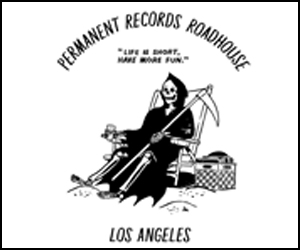Zola Jesus breathes life into all of the the mammals at First Fridays at the Natural History Museum
Kevin Bronson on
1
Nika Danilova, the Wisconsin-bred, L.A.-based songstress who does business as Zola Jesus, has nothing if not a sense of place. “Thanks for coming to this beautiful venue,” she told the crowd Friday night in the North American Hall of Mammals at the Natural History Museum, “that makes us appreciate where we came from, and probably where we will go back to.”
Her haunting music, as heard on her riveting 2011 album “Conatus” and as displayed in the echo-laden performance space at the museum’s monthly First Fridays event, displays the same quality, especially when it comes to her ballyhooed vocals. Much has been made of her opera-trained pipes, but Danilova is really only capable of blowing your ears back for few notes in the middle of the alto range. She owns those and merely finds the others, with nothing extraordinary about the phrasing either.
- ||| Photos by Debi Del Grande
Instead, it’s where her voice is located in the mix that makes Zola Jesus’ incantational songs so magical. It darts beneath and then rises above often-hypnotic orchestration of minimalist synths, mournful electric violin and tribal percussion, creating the same kind of emotional ebb and flow (and sense of wonder and mystery) as Sweden’s Fever Ray.
And on Friday night in a room full of mammals – some engaged in heavy breathing and some breathing not at all – the 22-year-old succeeded in squeezing every ounce of gravitas possible out of her songs. Her band’s rhythms sounded particularly muscular, and she seemed transported by them, foraying into the crowd during “Seekir” and receding into the dim blue light for the cathartic “Skin.”
If nothing else, opening act EMA – the nom de tune and initals of Erika M. Anderson – answered the always-pertinent question “If you were a sandwich, what kind of sandwich would you be?”
Wearing a T-shirt that read “Ham on Rye,” EMA did her best to quell the chatty crowd, only accomplishing that at the end with her Golden State kiss-off song “California,” during which she wrapped the microphone cord around her neck in feigned agony. She looked and sounded the part of damaged diva, a feeling she transferred in some of her music’s trance-like moments. A slab of two of musicality between those slices of bread would be more tasty.

















Caught Zola at Echplex 3 months back. She was pretty spell binding. Audience ate it up.